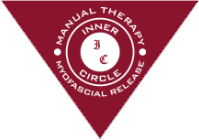Inner Circle is proud to support the continued research and education in understanding and treating cancer in a safe, holistic and effective manner. This installment of Inner Circle Insights is shared in honor of Breast Cancer Awareness Month.
Many of you have become aware of how Myofascial Release should be a part of the treatment plan for any diagnosis, as well as a part of your general health and wellness regimen. However, when we discuss the “Big C”, the idea that manual therapy has a place can be confusing.
To assist in better understanding the place that Myofascial Release, performed by a skilled therapist, can have in all phases of disease or dysfunction, we are sharing two “Therapeutic Insight” articles that appeared in MASSAGE Magazine authored by the Father of Myofascial Release, John F. Barnes, PT.
Therapeutic Insight: The John F. Barnes Myofascial Release Perspective:
Mastectomy, Breast Reduction and Augmentation
September 4, 2012, Massage Magazine
Myofascial release can be helpful post-surgery following mastectomies, breast reduction and augmentation. Once healing has occurred after a mastectomy, myofascial release techniques performed below and above the scar area can be helpful in eliminating the pain; this technique can also soften the scar.
However, scars grow inside the body like a vine, and can reach into the respiratory diaphragm and into the neck. This can cause breathing problems and—due to the strength of the vine—create a pulling sensation, forcing the client forward, which creates a posterior strain in the back and neck, resulting in headaches, as well as neck and back pain.
Breast augmentation scars are usually under the breast, resembling a “C” on its back. It then can come up under the breast midline, and there usually is a scar around the nipple. The nipples have to be repositioned and many sensory nerves are severed. The resulting scar is often not attractive, and can become thick and dark. Myofascial release can be helpful in softening and lightening up these scars. Many times the sensory nerves become hypersensitive and the breasts cannot be touched. Bras and blouses can also become uncomfortable to wear.
Augmentation is performed most of the time for cosmetic reasons or after mastectomies. Too many times the breasts do not look natural; they can become hard and do not feel or look normal. Sometimes the breasts are not level. Unfortunately, many surgeons do not recognize that fascia twists throughout the body, creating torque. When the patient is lying on the surgical table, breasts appear to be level, but since they are not naturally positioned (not standing) and “out of gravity,” it is not until the woman stands up that you can see the fascia drag, which creates a high or low breast. After augmentation, breasts can also become hypersensitive or have decreased sensation. Myofascial release can reposition the breast of the female client and create a more soft, supple and natural appearance.
Sincerely,
John F. Barnes, P.T., L.M.T., N.C.T.M.B.
Therapeutic Insight: The Myofascial Release Perspective – Breast Health
June 1, 2010 article in MASSAGE Magazine
Myofascial release has been helpful in treating endometriosis, pelvic pain, menstrual cramps and pain, frequency, urgency and incontinence. It has also been successful in treating ovarian and breast cysts.
What is a cyst? A cyst is a fascial restriction that has blocked the fluid flow of an area, forcing the area to swell, become inflamed and be painful. Myofascial release is safe and can gently soften and release the cyst, so the tissue can heal and return to normal.
I would like to share with you a case history of a brave woman—and massage therapist – Peggy Smith.
Case history
In October 2006, I received biopsy results confirming breast cancer, specifically “infiltrating ductal carcinoma.” I wasn’t completely shocked by the news, as I had received a breast cancer diagnosis in 2003 in my other breast. My treatment at that time consisted of a lumpectomy, sentinel lymph node biopsy and six weeks of radiation. When my surgeon called with the biopsy results in 2006 and wanted to schedule me the following week for a mastectomy, I was stunned and overwhelmed with fear. The several weeks of appointments, scans and biopsies, both needle and surgical, had been physically and emotionally exhausting, but I assumed all along that I would be given treatment options. I had heard how emotionally devastating mastectomy surgery could be and I was also concerned about potentially having to deal with lymphedema and/or loss of upper-body strength, but my surgeon insisted that because I had two cancerous tumors, I had no choice.
Fortunately, as a massage therapist, I had attended several of John Barnes’ myofascial release seminars to learn and experience this healing therapy. If I had to go through surgery, I knew I would cope with it better and recover faster if I received myofascial release therapy beforehand. So, I postponed the surgery and scheduled an intensive at John’s Eastern Myofascial Release Treatment Center in Paoli, Pennsylvania. After just one day of treatment, the larger of the two lumps felt smaller—and by the end of the week, it was difficult to locate. I was very excited and encouraged by this result. After feeling such positive change in just one week, I certainly wanted to give myofascial release therapy more time for further improvement, and I chose to cancel the surgery.
However, my surgeon did not share my excitement and insisted his ultrasound results indicated the tumor was the same size or larger. He also declined my request to order another MRI for comparison purposes, and I decided it was best to find another doctor.
I have had no further surgery since the biopsies in 2006. I continue to return to John’s Myofascial Release Treatment Centers for myofascial release therapy and I use myofascial release techniques to self-treat regularly. My mammogram and ultrasound results from June 2008 indicate “benign findings bilaterally.” My blood work tested in October 2008 is all within normal range and my oncologist told me, “Whatever you’re doing, keep doing it.”
In an e-mail, dated June 30, 2009, Peggy wrote:
I’m excited to share my recent (6/30/09) breast caner ultrasound and mammogram results: “The results of your recent exam indicate no suspicion of breast cancer.”
Thank you, Peggy. Your courage is remarkable.
This case study shows myofascial release is an important part of women’s health. In addition, a new article titled, “We are Not Mindless Machines,” which will be featured in the July issue of MASSAGE Magazine, discusses the treatment of cancer with myofascial release.
Sincerely,
John F. Barnes, P.T., L.M.T., N.C.T.M.B.
John F. Barnes, P.T., L.M.T., N.C.T.M.B., is an international lecturer, author and acknowledged expert in the area of myofascial release. He has instructed more than 100,000 therapists worldwide in his myofascial release approach, and he is the author of Myofascial Release: The Search for Excellence (Rehabilitation Services Inc., 1990) and Healing Ancient Wounds: The Renegade’s Wisdom (Myofascial Release Treatment Centers & Seminars, 2000). He is on the Council of Advisors of the American Back Society; he is also on MASSAGE Magazine’s Editorial Advisory Board; and is a member of the American Physical Therapy Association.


 Our first ever FREE workshop, introducing new people to the Inner Circle way of life, was a resounding success! For anyone you know who has ever asked about how Inner Circle is different and would benefit from our unique and holistic approach to healing is invited to join us. The workshops are held once a month on Saturday mornings – please contact our office for details and to register or click the link below. Remember, it takes strong shoulders to toss turkeys!
Our first ever FREE workshop, introducing new people to the Inner Circle way of life, was a resounding success! For anyone you know who has ever asked about how Inner Circle is different and would benefit from our unique and holistic approach to healing is invited to join us. The workshops are held once a month on Saturday mornings – please contact our office for details and to register or click the link below. Remember, it takes strong shoulders to toss turkeys! Healing is a Process
Healing is a Process The votes were all cast, the ballots tallied and the final vote count stands… Inner Circle has won The Best of Bucks 2019! The Four Bagger has been achieved!!
The votes were all cast, the ballots tallied and the final vote count stands… Inner Circle has won The Best of Bucks 2019! The Four Bagger has been achieved!!
 As we announced in our last message, Inner Circle has been nominated as The Best of Bucks 2019! Voting for the finals begins this Sunday, June 23rdand will run through Sunday, July 7th.
As we announced in our last message, Inner Circle has been nominated as The Best of Bucks 2019! Voting for the finals begins this Sunday, June 23rdand will run through Sunday, July 7th.